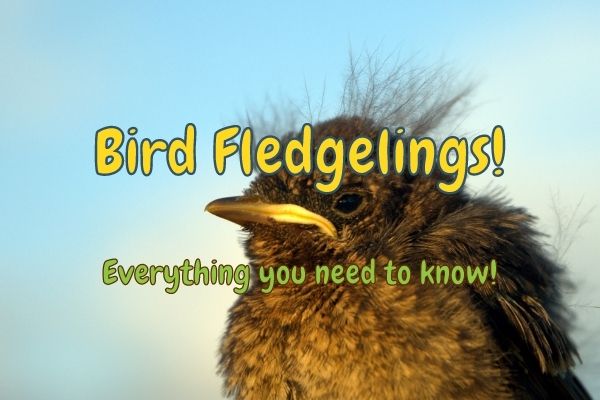If you’ve been outside in springtime, you may have seen young birds that are not quite babies and not quite adults. These little fledglings are everywhere in springtime, but what is so special about these immature birds?
Fledgling is the state a bird enters after being a “nestling” (baby) and can be compared to the state of a human teenager – they are almost ready to be on their own and have just left the nest to pursue their own life!
Whereas nestlings are completely naked, fledglings have small fine feathers, that are not yet entirely mature.
The word “fledging” refers directly to the first growth of feathers that occur to make their wings ready for flight and their bodies insulated from the cold.
We’ll talk about what they look like, where they sleep, what they eat, and when they leave the nest. We’ll also provide some tips on how to help them get started in life. So if you’re curious about bird fledglings, keep reading!
Contents
Where do fledglings sleep at night?
Fledglings usually sleep in the trees near the nest they have just left. Once they start hopping around and testing their wings more, they will start to sleep in trees or bushes that are further away.
Fledglings, the young birds that have recently acquired their flight feathers, are at an exciting stage in their development as they begin to explore their surroundings and learn crucial survival skills.
When it comes to their sleeping habits, fledglings exhibit different behaviors depending on their species, ecological niche (where they live), and individual circumstances. While there is no one-size-fits-all answer to where fledglings sleep at night, several common patterns can shed light on their nighttime roosting preferences.

In my experience as a biologist and backyard owner, I have observed that many fledglings tend to return to their nest or roosting site at night. Nests, which serve as secure and familiar shelters for young birds, provide protection from predators and adverse weather conditions – but the parents are not always happy with the visiting teenage birds!
During my field research, I have seen fledgling birds, such as robins and sparrows, tucking themselves into the safety of bushes and shrubs as darkness descends. These dense vegetations are typically located a few meters above or on the ground, depending on the species.
Some birds, such as pigeons and doves, build rather flimsy nests that are not suitable for accommodating growing fledglings. In such cases, fledglings may seek alternative roosting sites. For instance, I vividly remember an encounter with a fledgling pigeon during my research, which had taken refuge on a window ledge of a tall building. This resourceful young bird had found a relatively safe and elevated spot to spend the night.
Another interesting observation I made while studying fledglings was that certain species exhibit communal roosting behavior. This means that several fledglings from the same or related species gather together to sleep in a communal roost.
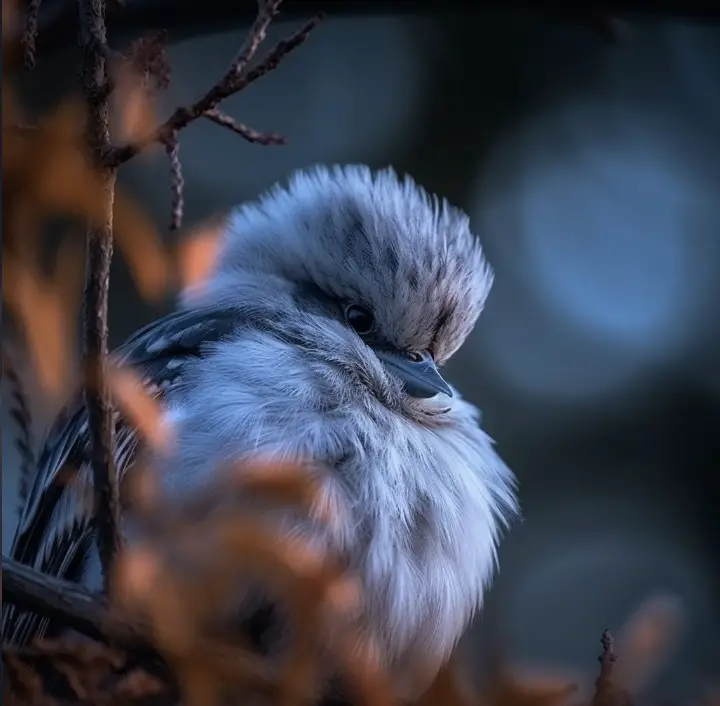
This behavior can be observed in species like swallows and starlings. These communal roosts can be in a variety of locations, such as dense vegetation, cliffs, or man-made structures. During my fieldwork, I witnessed thousands of starlings returning to a communal roost in a reed bed, creating a mesmerizing spectacle as they synchronized their flight and settled down for the night.
It is important to note that while many fledglings prefer roosting in familiar and secure locations, some species, such as certain raptors and seabirds, are known to sleep while perched on branches, cliffs, or even in mid-flight. These birds have adaptations that allow them to maintain their balance and grip, ensuring they don’t fall during sleep. These fledglings rely on their talons or specialized toe arrangements to secure themselves to their roosting site while they rest. In my research on raptors, I have seen fledglings like owls and hawks perching on branches or rocky outcrops, their eyes closed in peaceful slumber.
In conclusion, the question of where fledglings sleep at night is multifaceted and depends on various factors. While many fledglings return to their nests or find alternative roosting sites, others engage in communal roosting or adopt specialized perching behaviors.
These diverse sleeping habits are a testament to the adaptability and resourcefulness of young birds as they navigate the early stages of their independent lives.
Through my experiences as a biologist, I have been privileged to witness these remarkable behaviors and gain a deeper appreciation for the intricate lives of fledgling birds.
What if I find a fledgling on ground at night?
Ah, discovering a fledgling on the ground at night can certainly be an intriguing encounter for any nature enthusiast or concerned individual. As a biologist with experience in ornithology, I have had the opportunity to encounter such situations and understand the importance of proper care for these young birds.
Allow me to elaborate on what you should do if you happen to find yourself in this situation, drawing upon my knowledge and personal experiences in the field.
First and foremost, it is crucial to understand that finding a fledgling on the ground at night is not an uncommon occurrence.
Fledglings, which are young birds that have recently left the nest and are still in the process of learning to fly, often spend time on the ground during this period. This behavior is perfectly normal and part of their natural development. They may hop around, hide in foliage, or even seek shelter under bushes or low-hanging branches.
While it is generally best to leave wildlife undisturbed, it is understandable that you might feel concerned for the well-being of the fledgling, especially if it is nighttime. In such a scenario, a compassionate approach can go a long way. Keep in mind that birds have different adaptations and behaviors suited for various situations, including navigating in low light conditions.
If you encounter a fledgling on the ground at night, consider the following steps:
- Assess the situation: Observe the fledgling from a distance to determine if it appears injured, weak, or in immediate danger. If it seems healthy, active, and capable of moving, it is likely better to leave it be and allow its parents to care for it. Trust the natural instincts of the bird’s parents, as they are often nearby, monitoring and providing support to their young.
- Provide minimal assistance, if necessary: If the fledgling appears to be injured or in immediate danger, you may gently place it in a nearby tree or shrub. Choose a location that closely resembles its natural habitat, as this will increase the likelihood of its parents finding and caring for it. It is essential to handle the fledgling with care, using gloves or a cloth to avoid transferring any human scent, which could potentially deter the parents from returning to their young.
- Monitor from a distance: After assisting the fledgling, if required, it is crucial to maintain a safe distance and observe from afar. This approach allows the parents to locate and tend to their young without human interference. Bird parents are remarkably dedicated and capable of caring for their offspring, often continuing to feed and protect them even after they have left the nest. It may take several hours or even an entire night for the parents to locate and attend to the fledgling.
- Avoid unnecessary intervention: It is essential to avoid unnecessary intervention or attempts to raise the fledgling yourself. Despite our good intentions, human care is rarely a suitable substitute for the specialized care and nutrition provided by the bird’s parents. Furthermore, interfering with wildlife can disrupt natural processes and may inadvertently cause more harm than good.
In summary, if you find a fledgling on the ground at night, it is important to assess the situation, provide minimal assistance if necessary, and then monitor from a distance. Remember that birds are well-adapted to their environments and have evolved intricate behaviors to raise their young successfully. By allowing the fledgling’s parents to care for it, you are giving it the best chance of survival and ensuring its natural development. Our role as concerned observers is to appreciate the wonders of nature and respect the delicate balance of wildlife.
When do fledglings leave the nest?
A bird fledgling is defined as being in the state where the bird has grown feathers and just left the nest, so in fact, nestlings leaving the nest is pretty much what defines them as fledglings in the first place!
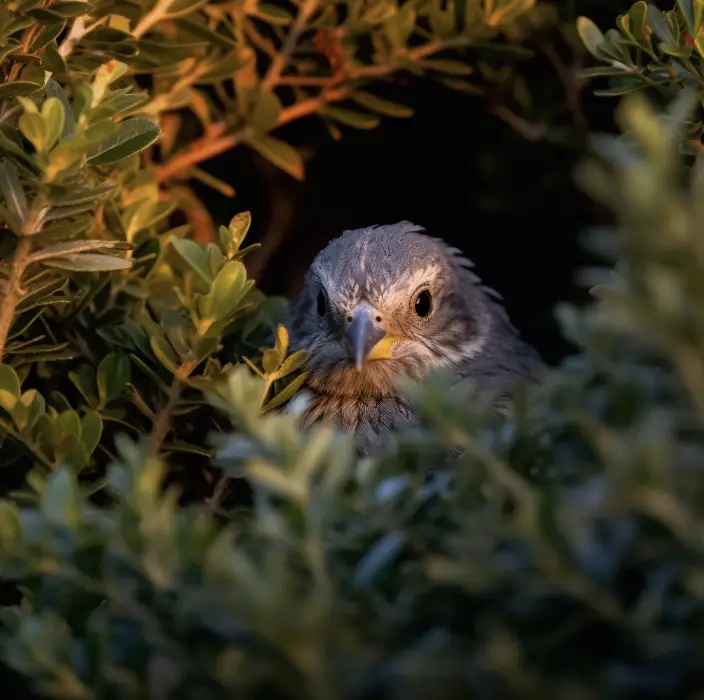
Most nestlings leave the nest about two weeks after they hatch. However, some may stay in the nest for up to four weeks. It depends on the bird species how quickly they learn to fly and hunt for food.
Blue Jays, for example, are ready to leave the nest very quickly, while American Robins take a little longer.
American goldfinch nestlings turn into fledglings 2-3 weeks after hatching and are ready to leave the nest by then.
But what time of the day do birds fledge?
According to a scientific study on the leaving habits of different bird nestlings, it is most common for nestlings to leave the nest early in the day and most most birds fledge before 6 am!
So if you want to observe this astonishing first jump of a fledgling into adulthood, you better get up early.
Songbirds like robins and sparrows typically fledge from the nest about 10 to 15 days after hatching, while larger birds like eagles or herons may spend several weeks in the nest before fledging.
Observing fledglings leaving the nest is a remarkable experience that has left a lasting impression on me. I vividly remember monitoring a family of Eastern Bluebirds in my research project. After closely monitoring the nest for several weeks, I noticed the fledglings becoming more restless and eager to explore their surroundings. They started exercising their wings by flapping vigorously and hopping along the edge of the nest.
One morning, I arrived at the nest and found it empty. The fledglings had taken the momentous leap and left the nest behind, venturing into the world beyond. Witnessing this event brought a mix of emotions—excitement for the fledglings’ newfound independence and a sense of bittersweetness as I realized the end of a chapter in their lives.
The exact trigger for fledglings to leave the nest varies, but it often involves a combination of physical development and environmental cues. As the fledglings grow, their flight feathers reach maturity, enabling them to take flight and navigate their surroundings. Additionally, parental birds play a crucial role in encouraging fledglings to leave the nest by reducing their food provisions and providing less frequent visits. This gradual withdrawal of parental care incentivizes the fledglings to explore and seek food independently.
I recall a specific study on Great Horned Owls, where researchers observed the fledgling owls gradually venturing out of the nest and onto nearby branches. The parents would still provide food for the fledglings, but their visits became less frequent over time. Eventually, the fledglings started making short flights between nearby trees, strengthening their flight muscles and gaining confidence.
The decision to leave the nest and fledge into the world is not without risks. Fledglings face numerous challenges, including predators, unfamiliar environments, and potential lack of adequate food sources. It is during this critical period that their survival skills are put to the test, and they must rely on their innate abilities and learning from their parents to thrive.
In conclusion, the timing of fledglings leaving the nest varies among bird species and is influenced by multiple factors such as species-specific development, environmental cues, and parental behavior. Having spent countless hours studying and observing bird behavior, I can attest to the remarkable nature of this phase in a bird’s life. Witnessing fledglings taking flight for the first time is an awe-inspiring moment that never fails to evoke a sense of wonder and appreciation for the beauty of nature.
Where do baby birds go when they leave the nest?
When the baby birds leave the nest, they effectively become fledgelings and are no longer considered “babies”.
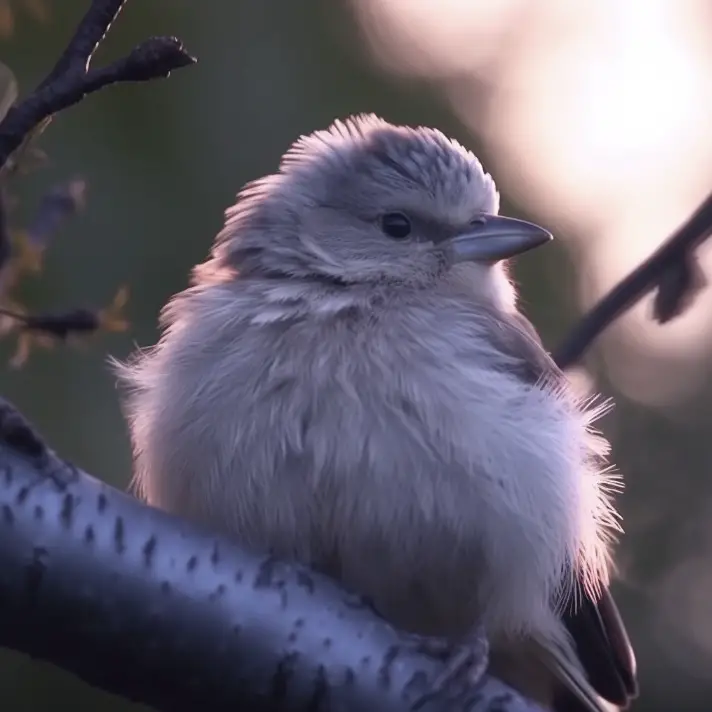
Most birds like, wrens, starlings, blue jays or robins, simply fly to either the ground or bushes and trees nearby. They will find a safe spot where they rest for some time until they are ready to start exploring the area a bit more.
Interestingly, some birds, like swiftlets, cannot walk, and they will have to fly right away and keep themselves in the air, right after they leave the nest!
Because a newly fledged bird is usually fed by its parents, it does not go too far away from the nests but waits patiently for the parents to come around and feed it.
What do fledglings eat?
Fledglings, such as that of goldfinches that I wrote about previously, eat a variety of things, including insects, worms, spiders, and fruit.
Their parents make sure that they eat a diet high in insects to make sure they get enough protein to grow as fast as possible.
They sooner they grow up, the sooner they can catch their own food and escape predators.
They learn to catch insects by watching their parents but also inherit some of their preferences as instincts.
Contrary to the newly hatched nestlings, they can eat seeds and animals that are not as soft as required for baby birds.
One of the most crucial phases in a bird’s life is the period following fledging, when the fledgling gradually develops the ability to fly. During this time, their nutritional needs change drastically. Initially, bird parents typically provide a diet rich in regurgitated food, which is highly nutritious and easy to digest for the young ones.
This regurgitated food often consists of a mixture of insects, worms, spiders, and even small fish or amphibians, depending on the species and the habitat they inhabit.
I remember watching a pair of Barn Swallows tending to their nest of fledglings, diligently bringing back a continuous supply of insects to feed their hungry brood. It was fascinating to witness the seamless coordination between the parents and their fledglings during feeding sessions.
As the fledglings grow, their parents begin to introduce them to a wider variety of food sources, allowing them to explore and learn to feed themselves. During this stage, the diet of different bird species can vary significantly based on their ecological niche and available resources.
Some fledglings, like those of seed-eating birds such as sparrows or finches, start consuming a blend of seeds and plant matter as they develop their bill and jaw strength. My observations of House Sparrow fledglings revealed how they progressively shifted from an insect-based diet to incorporating seeds and grains, mimicking the foraging habits of their parents.
In contrast, fledglings of insectivorous species, such as flycatchers or warblers, tend to consume a more insect-based diet throughout their early developmental stages. I remember spending hours in the field, observing the activities of fledgling warblers as they eagerly pursued insects. The parents would often demonstrate the hunting techniques, catching insects in mid-air and then presenting them to their fledglings to facilitate the learning process. It was remarkable to witness the fledglings’ initial clumsy attempts at capturing insects and their gradual improvement over time.
For piscivorous bird species, such as herons or kingfishers, the fledglings’ diet heavily relies on aquatic food sources. These young birds often accompany their parents to the water’s edge or perch near water bodies, eagerly waiting for a chance to snatch small fish or aquatic invertebrates.
I recall studying the behavior of fledgling Green Herons, patiently observing their parents as they captured small fish and then skillfully manipulated them to ensure their offspring could easily swallow the food.
It is important to note that the dietary habits of bird fledglings are not solely determined by their species, but also by their individual development and learning process. While there are general patterns, there can be variations within a species or even among siblings. Factors such as food availability, parental teaching, and individual learning capacity play significant roles in shaping the fledglings’ dietary preferences and foraging skills.
As a biologist, I find the dietary transition of bird fledglings to be a remarkable phenomenon. It is a testament to the intricate balance between instinct and learning that allows these young birds to acquire the necessary skills to survive and thrive in their respective habitats.
Through my personal experiences and observations in the field, I have gained a deep appreciation for the intricacies of avian biology, particularly in relation to the diet and foraging behaviors of bird fledglings
How often do fledgling birds eat?
Just as nestlings, young fledglings will typically eat the insects their parents catch for them every few hours and around 4-7 times per day, but as they get older, they will start to eat less frequently and find their own food.

In the beginning, even though they have left their nest fledglings are still fed by their parents, because it usually takes a few weeks for the young birds to master the art of catching their own food.
What does a fledgling blackbird look like?
Fledgling blackbirds are mostly brown, but they have a few brown scruffy feathers on their heads.
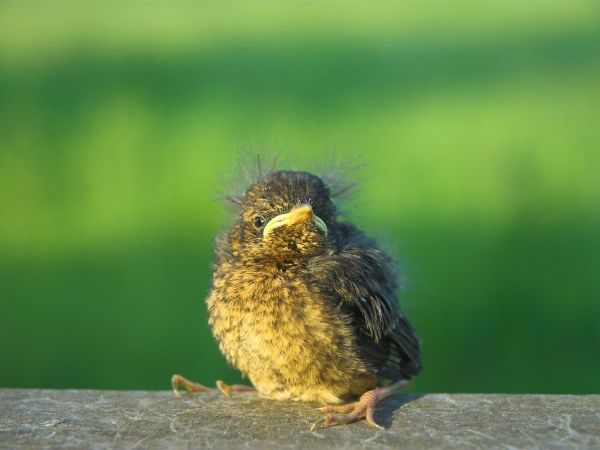
As they get older, their feathers will start to change color until they look just like adult blackbirds.
How can I help fledglings?
If you find a fledgling bird on the ground, there are a few things you can do to help it out. First, try to put the bird back in the nest.
If that’s not possible, or if the bird is injured, you can place it in a small box and keep it in a warm, dark place. Be sure to provide water and food (insects are best) until the bird is able to fly and hunt for food on its own.
If you find a baby bird that has not yet left the nest, it is best to leave it there and let the parents take care of it.
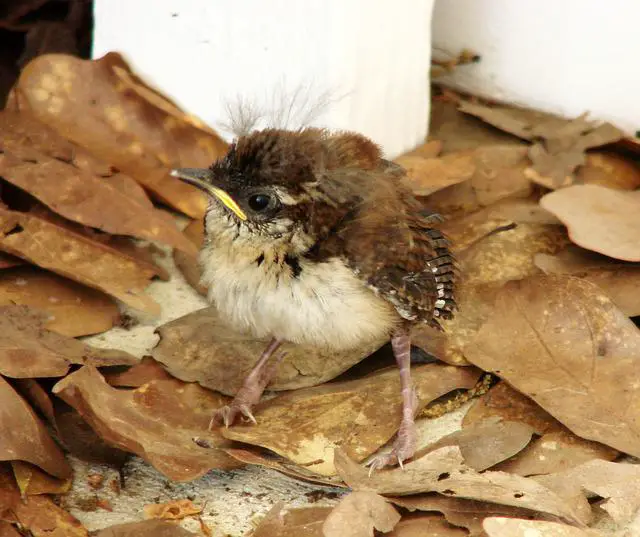
Fledglings that have not left the nest yet are still being fed by their parents, and it is usually best to let nature take its course.
However, if you are worried about the safety of the baby bird, you can try to put some food, like smaller worms and insects into its mouth.
If that’s not possible, you can place the bird in a small box and keep it in a warm, dark place until it is able to fly and hunt for food on its own.
Some people say that the bird’s parents will reject a baby bird if you touch it, but this is not necessarily true. If you are truly worried about the bird, it is best to try and help it in some way.
How to protect fledglings from cats?
It is important to keep cats away from fledgling birds, as they can be very harmful. Cats will often eat baby birds, and they can also injure or kill them.
If you have a cat, be sure to keep it inside until the baby birds have left the nest and are old enough to escape a potential attack!
Furthermore, it is important to educate the community about the risks that free-roaming cats pose to fledgling populations. Many individuals are unaware of the impact their cats can have on local bird populations and may not realize the potential harm caused by allowing their pets to roam freely outdoors.
Based on my experience working with local conservation organizations, conducting public outreach programs and educational campaigns have proven effective in raising awareness about the issue and encouraging responsible cat ownership.
Implementing successful cat management programs can also contribute significantly to the protection of fledglings. Municipalities and organizations can promote responsible pet ownership by advocating for cat confinement or encouraging the use of outdoor enclosures, commonly known as “catios,” that allow cats to experience the outdoors safely without endangering wildlife.
These measures help reduce the potential interactions between cats and fledglings, creating a safer environment for the young birds to thrive.
In conclusion, protecting fledglings from cats requires a multi-faceted approach that includes creating safe nesting environments, minimizing ground exposure, educating the community, and implementing cat management programs.
As a biologist passionate about avian conservation, I have personally witnessed the positive impact of these strategies on fledgling survival rates. By implementing these measures, we can enhance the chances of fledglings successfully navigating this critical stage in their lives and contribute to the preservation of bird populations for future generations to enjoy.
How to feed a fledgling magpie?
Fledgling magpies are very curious birds, and they will often come close to people in order to get a better look.
If you find a fledgling magpie on the ground, you can try to put it back in the nest if you know where it is.
If that’s not possible, or if the bird is injured, you can place it in a small box and keep it in a warm, dark place.
I recently wrote about the natural diet of baby and fledgeling magpies and it is an interesting example of how the diet of birds can be quite similar throughout the life of a bird. But you will need to feed the babies softer foods than the fledgelings and adults eat!
You can feed it the following foods in the first couple of weeks: mealworms, waxworms, maggots, crickets, and small spiders. Mashed egg mixed with water may also work well.
Unless you want the magpie as a pet, be careful not to touch a fledgling magpie too much, as they may think you are their parent and start to follow you around!
My uncle had a pet magpie, which was quite cute and he actually taught it to say a few words!
What to feed fledgling blue jays?
Fledgling blue jays are mostly gray when they first leave the nest, but their feathers will start to change color as they get older into the characteristic bright blue that we know blue jays for.
Young blue jays mostly eat: insects, berries, and seeds, however, only feed it soft items or try to soak the seeds in water to make them more digestible for the bird.
When it comes to feeding fledgling blue jays, it is essential to understand their unique nutritional requirements and their natural diet.
Blue jays are known to be omnivorous birds, meaning they have a diverse diet that includes both plant and animal matter. In the wild, adult blue jays consume a wide range of foods such as seeds, nuts, fruits, insects, and even small vertebrates. However, the dietary needs of fledgling blue jays can differ slightly from those of their adult counterparts due to their rapid growth and development.
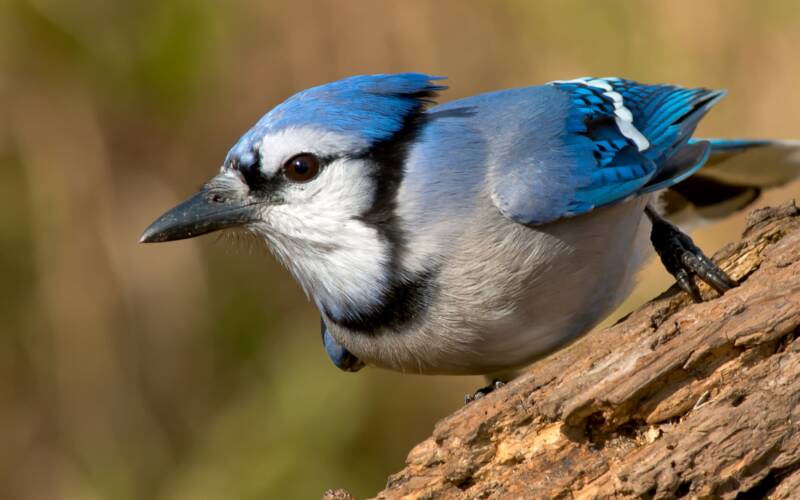
Feeding fledgling blue jays requires a balance of protein, fats, carbohydrates, vitamins, and minerals to support their growth and provide them with the necessary energy. During their early stages, when they are still in the nest, fledgling blue jays are primarily fed by their parents, who regurgitate a mixture of insects and other small invertebrates. This protein-rich diet is crucial for their development and helps them build strong muscles and feathers.
When it comes to supplementing the diet of fledgling blue jays in captivity or in cases where they are orphaned, it is important to mimic their natural diet as closely as possible. Providing a varied diet that reflects their omnivorous nature is key to their overall health and well-being.
To ensure the proper nutrition for fledgling blue jays, you can offer them a combination of commercially available insectivore diet, which provides the necessary proteins and nutrients, and a selection of fresh insects, such as mealworms, crickets, and ants. These insects can be easily obtained from specialized pet stores or even bred at home, depending on your preferences and resources.
Additionally, you can provide fledgling blue jays with a variety of soft fruits and berries, which are rich in natural sugars and provide an important source of energy. Examples include blueberries, strawberries, raspberries, and chopped apples. It is important to ensure that the fruits are ripe and cut into small, easily manageable pieces to prevent choking hazards for the fledglings.
While protein and fruit make up a significant portion of their diet, it is also important to include other food items to ensure a well-rounded nutritional intake. Seeds, such as sunflower seeds, can be offered, as well as small pieces of nuts. These provide essential fats and carbohydrates, contributing to the fledgling blue jays’ overall energy requirements.
However, it is important to note that fledgling blue jays have different dietary needs at different stages of development. As they mature, they gradually transition to a diet closer to that of adult blue jays. Therefore, it is crucial to monitor their growth and adjust their diet accordingly.
In my personal experience working with fledgling blue jays, I have found that providing them with a diverse and balanced diet greatly contributes to their overall health and successful development. It is important to ensure that the food provided is fresh, clean, and free from any potential contaminants. Regularly cleaning their feeding dishes and providing fresh water is also essential to prevent the growth of harmful bacteria.
In summary, when it comes to feeding fledgling blue jays, it is crucial to provide them with a varied and nutritious diet that closely mimics their natural food sources. A combination of commercially available insectivore diet, fresh insects, soft fruits and berries, as well as seeds and nuts, can help meet their protein, energy
How to care for a fledgling pigeon?
If you find a fledgling pigeon on the ground, there are a few things you can do to help it out. First, try to put the bird back in the nest.
If that’s not possible, or if the bird is injured, you can place it in a small box and keep it in a warm, dark place. Be sure to provide water and food (insects are best) until the bird is able to fly and hunt for food on its own.
What is a fledgling pigeon called?
Fledgling pigeons are called “squabs.” They are mostly white when they first leave the nest, and their feathers will start to change color as they get older.
What to feed a fledgling pink pigeon?
Fledgling pigeons are mostly white when they first leave the nest, but their feathers will start to change color as they get older.
They usually eat: seeds, fruits, berries, insects, and snails. Only feed it soft items or try to soak the seeds in water to make them more digestible for the bird.
The pink pigeon is an endangered species endemic to the island of Mauritius, and its population has been severely impacted by habitat loss and predation.
Therefore, proper nutrition during the fledgling stage is crucial for their survival and successful reintroduction efforts.
When it comes to feeding a fledgling pink pigeon, it is important to understand their natural diet and replicate it as closely as possible. In the wild, pink pigeons primarily feed on a variety of plant materials, including fruits, seeds, and leaves. These plant-based foods provide essential nutrients such as carbohydrates, proteins, fats, vitamins, and minerals required for their growth and development.
My personal experience working with pink pigeons in a conservation project on Mauritius has taught me the importance of offering a diverse and balanced diet to fledglings. One of the key components of their diet is soft fruits, such as guavas, papayas, and bananas. These fruits are not only rich in carbohydrates but also provide important vitamins like vitamin C, which is crucial for their immune system development.
Additionally, fledgling pink pigeons require a good source of protein to support their rapid growth. In the wild, they would obtain protein from various sources, including insects, worms, and snails. However, when hand-rearing a fledgling pink pigeon, it is important to ensure a reliable source of protein that is easily digestible. In my experience, feeding them a mixture of boiled egg and finely chopped mealworms has proven to be an effective method of meeting their protein requirements.
To ensure a well-rounded diet, it is also important to include a variety of vegetables and greens in their food. These can include options such as spinach, kale, grated carrots, and peas. These vegetables provide important vitamins and minerals, as well as dietary fiber, which aids in digestion.
It is worth noting that the feeding frequency and portion sizes will vary as the fledgling grows. Initially, when they are very young and just starting to eat solid food, feedings should be more frequent, around four to six times a day. As they grow older and become more independent, the frequency can be gradually reduced to three times a day. I have found that monitoring their weight gain and overall health is crucial in determining the appropriate feeding regimen.
In addition to the solid food diet, providing access to clean water is essential for the fledgling’s hydration and overall well-being. Make sure the water is fresh and changed regularly to prevent contamination.
While it is important to provide the fledgling pink pigeon with a suitable diet, it is equally vital to encourage their natural feeding behaviors. In my personal experience, I have observed that introducing some of their food in a manner that encourages foraging and pecking behavior helps stimulate their natural instincts and supports their overall development.
In conclusion, when feeding a fledgling pink pigeon, it is crucial to replicate their natural diet as closely as possible. This includes offering a variety of soft fruits, protein-rich sources like boiled egg and mealworms, and a selection of vegetables and greens.
Monitoring their weight gain, health, and adjusting the feeding regimen accordingly is essential. By providing a well-balanced diet and encouraging natural feeding behaviors, we can contribute to the successful growth and development of the fledgling pink pigeons, ultimately aiding in the conservation efforts of this endangered species.
Conclusion
Fledgelings are like the teenagers of birds – not quite babies, not quite adults! They are learning their ways as an adult bird, but they are still vulnerable and have a hard time finding their own food.
Luckily, most birds are good parents that help their fledgling bird to get a good start of life. Therefore, if you find a fledgeling, make sure the parents are not around to help it before taking over their job as they will likely do a better job.
However, should the parents really not be around, you might have the chance to save a frightened bird and give it a push into adulthood!

